Housing affordability remains a critical issue in Australia, with many prospective home owners finding it increasingly difficult to enter the market. As prices continue to rise, alternative housing models like Community Land Trusts (CLTs) are gaining attention for their potential to provide long-term affordable housing solutions.
But what exactly are CLTs, and how could they improve housing affordability in Australia?
In this article, we explore the concept of Community Land Trusts, how they work, and their potential impact on the Australian housing market.
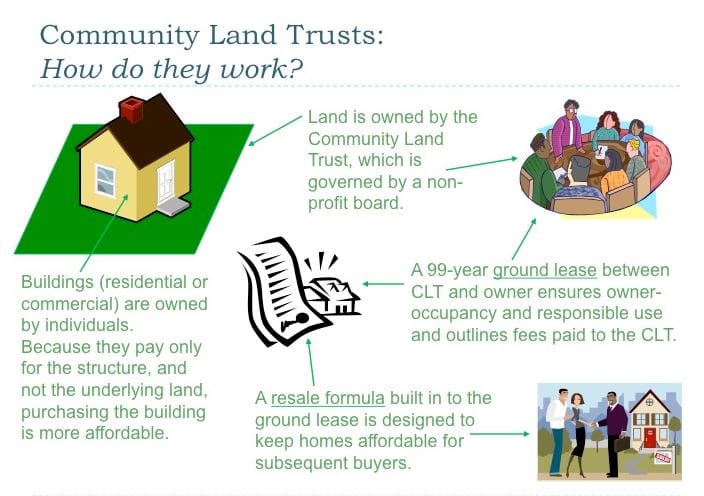
What Are Community Land Trusts (CLTs)?
Community Land Trusts (CLTs) are non-profit organisations that aim to provide affordable housing by owning land and leasing it to home owners. The model, which originated in the United States during the civil rights movement, has since spread globally as a means to combat housing inequality and land speculation.
At the core of the CLT model is the principle of separating land ownership from housing ownership. While the trust retains ownership of the land, the home owner owns the building on it. This unique arrangement helps to keep housing costs down by removing the land component from the price equation.
Key Principles of CLTs
- Separation of Land and Property Ownership: The CLT retains ownership of the land, leasing it to home owners through long-term agreements. This ensures that the land remains a community asset and that the housing remains affordable for future generations.
- Long-term Ground Lease: Home owners enter into a long-term (often 99-year) renewable lease with the CLT. This lease includes provisions that maintain the property’s affordability, such as resale price restrictions that prevent homes from being sold at market rates.
- Community Control: CLTs are typically governed by a board of directors that includes residents, community members, and public representatives. This structure ensures that the trust operates in the best interest of the community, with decisions being made collectively to serve the public good.
Differences Between CLTs and the Build-to-Rent (BTR) Model
Community Land Trusts (CLTs) and the Build-to-Rent (BTR) model are both innovative approaches to addressing housing challenges, but they serve different purposes and benefit distinct groups of people.
CLTs focus on creating long-term affordable home-ownership opportunities by separating land ownership from housing ownership, ensuring that homes remain affordable across generations. This model is particularly beneficial for low- to moderate-income families who seek stability, community involvement, and the opportunity to build equity in their homes while being protected from market volatility.
In contrast, the Build-to-Rent (BTR) model is designed to provide high-quality rental housing, often in urban areas, where tenants do not have the option to purchase the property. BTR developments are typically owned by institutional investors who rent out the units as a long-term investment. This model benefits renters who prioritise flexibility, access to modern amenities, and a lower commitment than home ownership.
BTR is particularly attractive to young professionals, transient workers, and those who may not yet be ready or able to purchase a home but still desire high-quality, well-managed living environments. While CLTs focus on affordability and community ownership, BTR caters to a rental market seeking convenience and quality without the responsibilities of ownership.
Read more about BTR in this article

Read about Build to Rent here and how it differs from CLT's
Global Examples of CLTs
While the concept of CLTs is relatively new to Australia, they have been successfully implemented in other parts of the world. For instance, the Burlington Community Land Trust in Vermont, USA, has provided thousands of affordable homes since its inception. In the United Kingdom, CLTs have been particularly effective in rural areas, where they address the shortage of affordable housing.
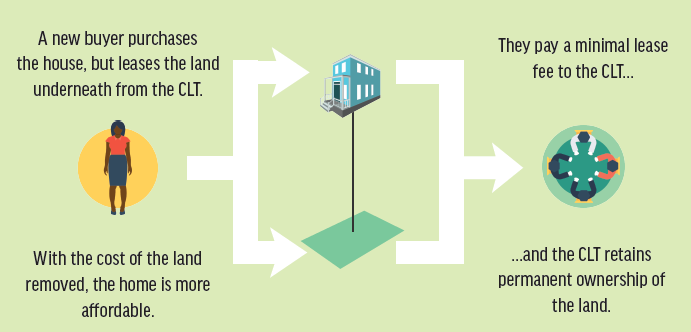
How Do Community Land Trusts Work?
Understanding the mechanisms of CLTs is key to appreciating how they can make a difference in the housing market. CLTs function as non-profit organisations, with their primary goal being the provision of affordable housing. Their structure and governance are designed to ensure that community interests remain at the forefront of their operations.
Structure and Governance
CLTs are governed by a board of directors, typically made up of three groups: residents who live in the CLT properties, community members who support the trust's mission, and public officials or representatives from local organisations. This tripartite structure ensures a balance of interests and keeps the focus on community benefit rather than profit.
The land within a CLT is owned by the trust itself, while the homes on the land are owned by individual home-owners. This separation of land and housing ownership is central to the CLT model, as it allows the trust to maintain control over land use while enabling residents to own their homes.
Land and Housing Management
The CLT retains ownership of the land and leases it to home owners through long-term, renewable leases. These leases typically last 99 years and include provisions to ensure that the homes remain affordable for future buyers. Home owners purchase the house but lease the land, significantly reducing the overall cost of buying a home.
When a home owner decides to sell, the CLT assists in finding a new buyer who meets the eligibility criteria. The resale price is determined by a formula set in the ground lease, ensuring that the home remains affordable for the next buyer while allowing the original home owner to recoup some of their investment.
Community Involvement and Support
CLTs thrive on community involvement. Residents and community members are encouraged to participate in the governance of the CLT, attend meetings, and contribute to decision-making processes. This community-driven approach ensures that the CLT remains responsive to the needs of the people it serves.
In addition to providing affordable housing, many CLTs offer support services to their residents.
These services might include financial counselling, home maintenance workshops, and community-building activities, all of which help residents succeed as home owners and strengthen the community as a whole.
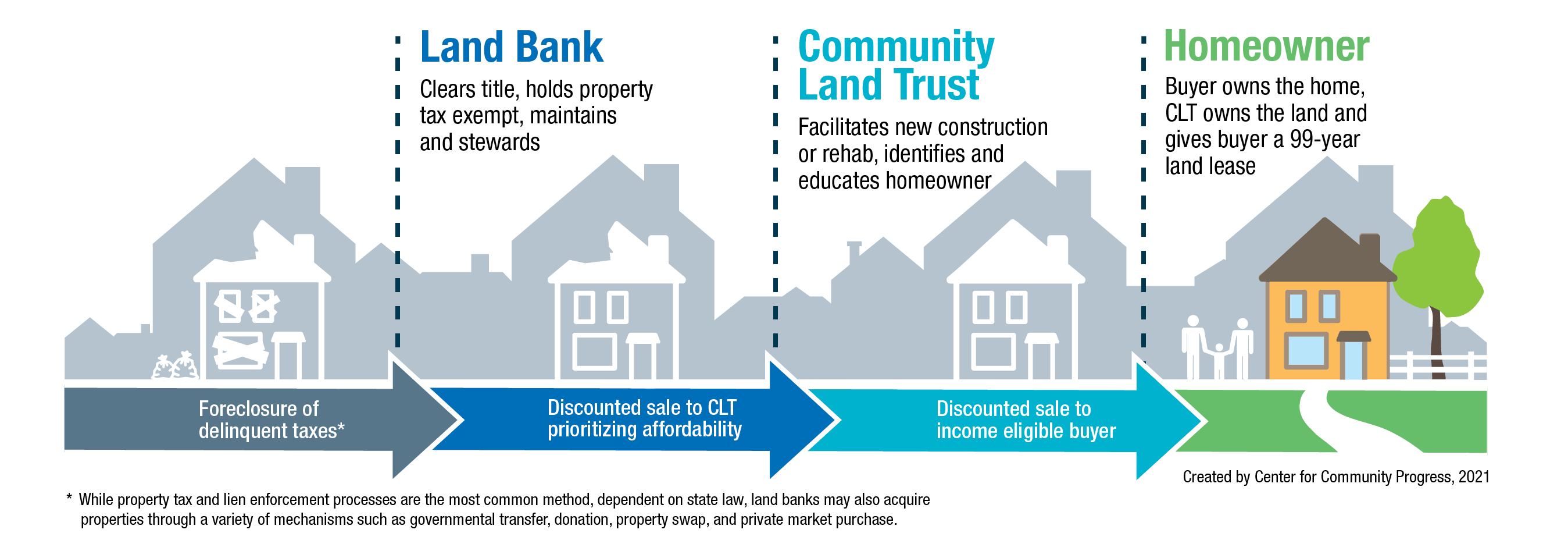
How Could CLTs Improve Housing Affordability in Australia?
The Australian housing market is currently facing significant challenges, with sky-rocketing prices and a shortage of affordable housing options. CLTs could play a crucial role in addressing these issues by providing a sustainable model for affordable home ownership.
Addressing Housing Affordability Challenges
The primary challenge in the Australian housing market is the high cost of land, which drives up property prices and puts home ownership out of reach for many. By separating land ownership from home ownership, CLTs can significantly reduce the cost of purchasing a home. This model allows for the creation of permanently affordable housing that is insulated from market fluctuations and speculation.
CLTs also promote long-term affordability. Unlike other affordable housing models that may only provide temporary relief, CLTs ensure that homes remain affordable for generations. This is achieved through the resale price restrictions included in the ground lease, which limit the profit a home owner can make when selling their home.
Comparison with Other Affordable Housing Models
While there are other affordable housing models in Australia, such as social housing and shared equity schemes, CLTs offer unique advantages. Social housing, for example, is typically government-owned and rented to low-income tenants, but it does not provide the opportunity for home ownership. Shared equity schemes allow buyers to purchase a portion of a home while the remaining share is owned by a government or non-profit organisation. However, these schemes can still be vulnerable to market pressures and may not guarantee long-term affordability.
CLTs, on the other hand, offer the security of home ownership while ensuring that housing remains affordable over the long term. This makes CLTs a particularly attractive option for addressing Australia’s housing affordability crisis.
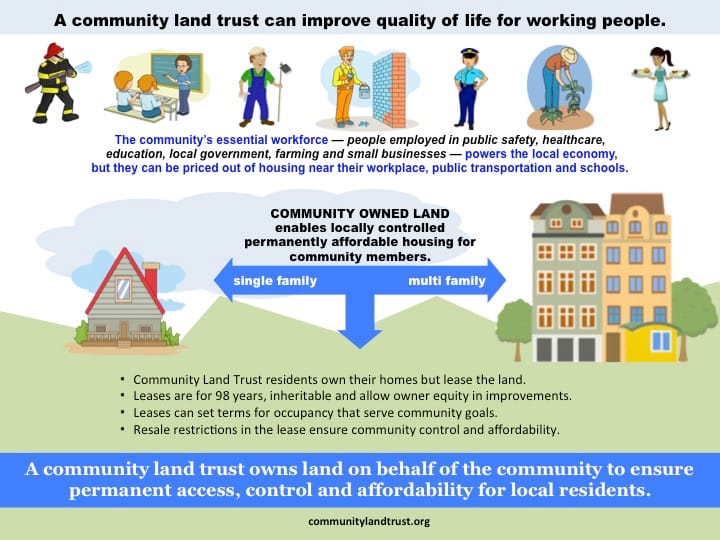
Pros and Cons of Community Land Trusts
While CLTs offer many benefits, they are not without their challenges. It is important to consider both the advantages and disadvantages of this model when assessing its potential impact on the Australian housing market.
Pros of Community Land Trusts
- Long-term Housing Affordability: CLTs ensure that homes remain affordable for future generations through resale price restrictions and community control.
- Community Empowerment and Cohesion: By involving residents in governance, CLTs foster a sense of community ownership and responsibility.
- Protection from Market Fluctuations: CLTs shield housing from the volatility of the market, providing stability for home owners.
Cons of Community Land Trusts
- Challenges in Scaling and Funding: Establishing and maintaining a CLT requires significant upfront investment and ongoing funding, which can be challenging to secure.
- Potential Limitations on Property Appreciation: Home owners in a CLT may see limited financial returns when selling their property due to resale price restrictions.
- Complexities in Governance and Management: The community-driven nature of CLTs can lead to challenges in decision-making and management, particularly as the organisation grows.
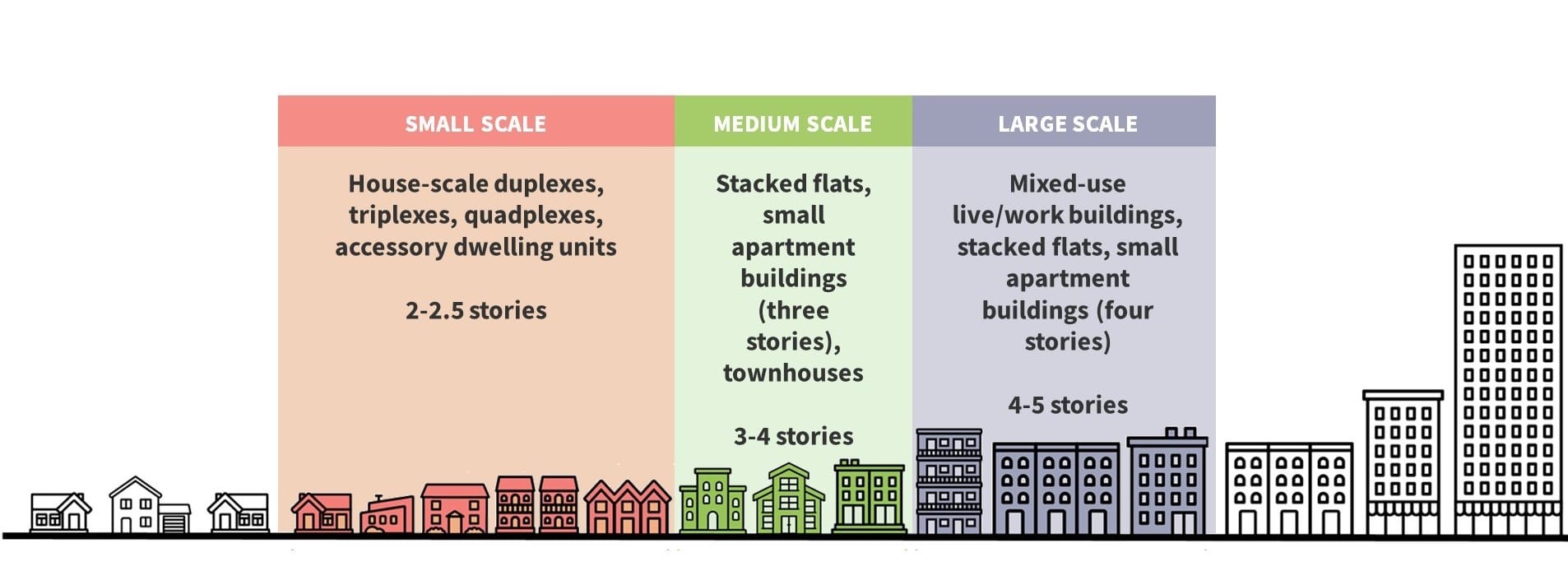
Implementing Community Land Trusts in Australia’s Current Economic Climate
Given the current economic conditions in Australia, with high interest rates and inflationary pressures, implementing CLTs may seem daunting. However, with careful planning and support, CLTs can be a viable solution to the housing affordability crisis.
Current Economic Conditions in Australia
Australia is currently experiencing high interest rates and inflation, which have put additional strain on the housing market. These economic factors make it even more difficult for prospective home owners to afford property, particularly in major cities where prices are already high.
Steps to Create and Sustain a CLT in This Environment
Despite these challenges, there are steps that can be taken to establish and sustain a CLT in Australia:
- Secure Funding: CLTs can be funded through a combination of government grants, private donations, and community fund-raising efforts. Partnerships with local councils and non-profits can also provide essential support.
- Policy Advocacy: Advocating for policy changes that support the creation of CLTs is imperative. This could include lobbying for government subsidies, tax incentives, and zoning laws that facilitate the development of CLTs.
- Community Collaboration: Engaging with local communities is essential for the success of a CLT. Building partnerships with community groups, non-profits, and other stakeholders can help to secure the resources and support needed to establish a CLT.
- Education and Outreach: Raising awareness about the benefits of CLTs is key to garnering public support. Educational campaigns, workshops, and informational sessions can help to inform potential home owners and community members about the advantages of this model.
Potential Policy Changes and Advocacy Needed
For CLTs to thrive in Australia, supportive policies and regulations are essential. This could include:
- Zoning and Planning Reforms: Ensuring that zoning laws support the development of CLTs by allowing for the necessary land use changes.
- Financial Incentives: Providing tax breaks or subsidies to encourage the creation of CLTs and make them financially viable.
- Supportive Housing Policies: Implementing policies that prioritise affordable housing and support the long-term sustainability of CLTs.

The Case for State Governments to Prioritise CLTs Over Developer Favouritism
State governments in Australia have long provided favourable terms to developers, incentivising them to build housing estates that often prioritise profit over quality. This approach has led to developers outsourcing construction to project builders who frequently deliver sub-par quality homes, undermining long-term housing stability and community satisfaction.
Moreover, as the housing market evolves,
there is a concerning trend where developers are beginning to cut out project builders entirely, choosing instead to control both the land development and construction processes.
This shift centralises power in the hands of developers, leading to a "get what we give you" housing solution that severely restricts consumer choice and undermines the diversity of housing options available to Australians.
In contrast, reinvesting in Community Land Trusts (CLTs) as a form of social housing offers a more sustainable and equitable alternative. CLTs prioritise long-term affordability, quality construction, and community involvement, ensuring that housing remains accessible and meets the needs of residents rather than serving the profit motives of developers.
By redirecting resources from developer incentives to CLTs, state governments can replenish dwindling social housing stocks, empower communities, and promote housing models that focus on quality and affordability. This shift would not only address the immediate need for affordable housing but also counteract the growing monopoly of developers, fostering a more balanced and just housing market in Australia.

Conclusion
As Australia struggles with an ongoing housing affordability crisis, the need for innovative and sustainable solutions has never been more urgent. Community Land Trusts (CLTs) offer a promising alternative to the traditional profit-driven models that dominate the housing market.
By separating land ownership from housing ownership, CLTs ensure that homes remain affordable across generations, empowering communities and providing stability in an increasingly volatile market. While there are challenges to implementing CLTs, such as securing funding and navigating the regulatory landscape, the potential benefits far outweigh these hurdles.
State governments have a important role to play in this transformation. By shifting their focus away from favouring developers—who often prioritise profit over quality—and instead reinvesting in CLTs as a form of social housing, they can replenish critical housing stocks and provide more equitable, long-term housing solutions. This approach not only counters the growing centralisation of power among developers but also ensures that housing quality and affordability remain at the forefront of Australia’s housing strategy.
As the housing market continues to evolve, embracing CLTs could be the key to creating a more just, sustainable, and resilient future for Australian communities. By fostering partnerships, supporting community-driven initiatives, and ensuring financial sustainability, CLTs have the potential to redefine the landscape of affordable housing in Australia, making home ownership a reality for many who might otherwise be left behind.
Frequently Asked Questions (FAQs)
- What is the difference between a CLT and other affordable housing models?
- CLTs provide a unique model where the trust retains ownership of the land while the home owner owns the building, ensuring long-term affordability.
- Can I sell my CLT home for a profit?
- Yes, but the resale price is typically capped to maintain affordability for future buyers.
- Who can live in a CLT home?
- CLT homes are usually reserved for low- to moderate-income families who meet certain eligibility criteria.
- How are CLTs funded and sustained?
- CLTs are funded through a mix of government grants, private donations, and community fund-raising efforts.
- What are the eligibility criteria for buying a CLT home?
- Eligibility is typically based on income levels and the need for affordable housing.
- How does a CLT ensure long-term affordability?
- Through resale price restrictions and community control, CLTs keep housing affordable for future generations.
- Are there any CLTs currently operating in Australia?
- Yes, there are emerging CLT projects in cities like Melbourne and Sydney.
- How can I get involved in starting a CLT?
- You can start by joining a local housing advocacy group, attending community meetings, or reaching out to organisations that support CLTs.
- What are the tax implications of living in a CLT home?
- Tax implications vary, but home owners may be eligible for certain tax breaks due to the non-profit status of the CLT.
- How does a CLT affect the value of surrounding properties?
- CLTs can stabilise the value of surrounding properties by providing affordable housing options and preventing displacement.
Further Reading












